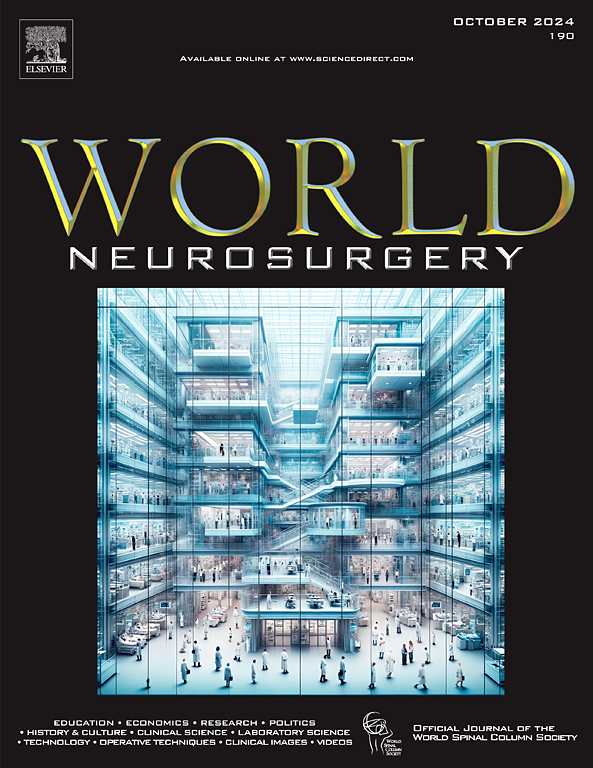远外侧入路枕骨肌间动脉的地形解剖及分步切除。
IF 1.9
4区 医学
Q3 CLINICAL NEUROLOGY
引用次数: 0
摘要
背景:枕动脉(ocitital artery, OA)是颅内和颅外搭桥手术的重要供动脉,但其路径曲折,难以采集。传统的肌间骨关节炎部分没有被肌肉覆盖,在手术中容易损伤。目前,关于如何保护OA的这一部分的报道很少。目的:通过解剖测量明确肌间骨关节炎的病程及其与不同肌肉的位置关系,探讨如何在远外侧入路快速、安全地采集枕动脉。方法:对17例经福尔马林固定的成人尸体头部33侧进行解剖测量,明确OA与头脾肌及颈上线之间的位置关系。通过远外侧入路,采用“反c形”手术切口,找到头脾肌最上肌纤维与SNL的附着,即OA穿过头脾肌的位置,以及OA与SNL相交的位置。测量这三点之间的距离,并测量OA的近端和远端直径。我们建议如何在远侧入路中以头脾肌为标志安全快速地切除OA。结果:在所有标本中,部分肌间骨性关节炎位于肌肉浅层肌腱和结缔组织以下。该区域位于头脾肌最上肌纤维内侧,SNL下方,胸锁乳突肌或斜方肌肌腱表面。该区域OA表面未见致密肌纤维,我们称之为头脾肌OA后段,长度为29.3±12.1mm。结论:经远外侧入路,头脾肌是显露骨关节炎的有效标志。我们在头脾肌最上肌纤维下13.6±5.2mm范围内进行解剖,可以安全、快速、准确地找到OA。本文章由计算机程序翻译,如有差异,请以英文原文为准。
Topographic Anatomy and Step-Wised Harvest of Intermuscular Occipital Artery in Far Lateral Approach
Background
The occipital artery (OA) is an important donor artery for intracranial and extracranial bypass surgery, but its path is tortuous, making it difficult to harvest. Part of the traditional intermuscular OA is not covered by muscle and is easily damaged during surgery. Currently, there are few reports on how to protect this segment of the OA.
Objective
To clarify the course of the intermuscular OA and its positional relationship with different muscles through anatomical measurements and to explore how to quickly and safely harvest the occipital artery in the far lateral approach.
Methods
Thirty-three sides of 17 formalin-fixed adult cadaveric heads (n = 33) were used for anatomical measurements to clarify the positional relationship between the OA and the splenius capitis muscle and the superior nuchal line (SNL). A "reverse C-shaped" surgical incision through the far lateral approach was used to find the attachment of the uppermost muscle fiber of the splenius capitis muscle to the SNL, the site where the OA passed through the splenius capitis muscle, and the site where the OA crossed the SNL. The distances between these 3 points were measured, and the proximal and distal diameters of the OA were also measured. We proposed how to safely and quickly harvest the OA using the splenius capitis muscle as a landmark in the far lateral approach.
Results
In all specimens, part of the intermuscular OA ran below the tendons and connective tissues in the superficial layer of the muscle. This area was located on the medial side of the uppermost muscle fibers of the splenius capitis muscle, below the SNL, and on the surface of the sternocleidomastoid muscle or trapezius muscle tendons. There were no dense muscle fibers on the surface of the OA in this area, which we referred to as the posterior segment of OA of the splenius capitis muscle, with the length of 29.3 ± 12.1 mm.
Conclusions
Through the far lateral approach, the splenius capitis muscle is a useful landmark to expose the OA. We can safely, quickly, and accurately find the OA by dissecting within 13.6 ± 5.2 mm below the uppermost muscle fiber of the splenius capitis muscle.
求助全文
通过发布文献求助,成功后即可免费获取论文全文。
去求助
来源期刊

World neurosurgery
CLINICAL NEUROLOGY-SURGERY
CiteScore
3.90
自引率
15.00%
发文量
1765
审稿时长
47 days
期刊介绍:
World Neurosurgery has an open access mirror journal World Neurosurgery: X, sharing the same aims and scope, editorial team, submission system and rigorous peer review.
The journal''s mission is to:
-To provide a first-class international forum and a 2-way conduit for dialogue that is relevant to neurosurgeons and providers who care for neurosurgery patients. The categories of the exchanged information include clinical and basic science, as well as global information that provide social, political, educational, economic, cultural or societal insights and knowledge that are of significance and relevance to worldwide neurosurgery patient care.
-To act as a primary intellectual catalyst for the stimulation of creativity, the creation of new knowledge, and the enhancement of quality neurosurgical care worldwide.
-To provide a forum for communication that enriches the lives of all neurosurgeons and their colleagues; and, in so doing, enriches the lives of their patients.
Topics to be addressed in World Neurosurgery include: EDUCATION, ECONOMICS, RESEARCH, POLITICS, HISTORY, CULTURE, CLINICAL SCIENCE, LABORATORY SCIENCE, TECHNOLOGY, OPERATIVE TECHNIQUES, CLINICAL IMAGES, VIDEOS
 求助内容:
求助内容: 应助结果提醒方式:
应助结果提醒方式:


